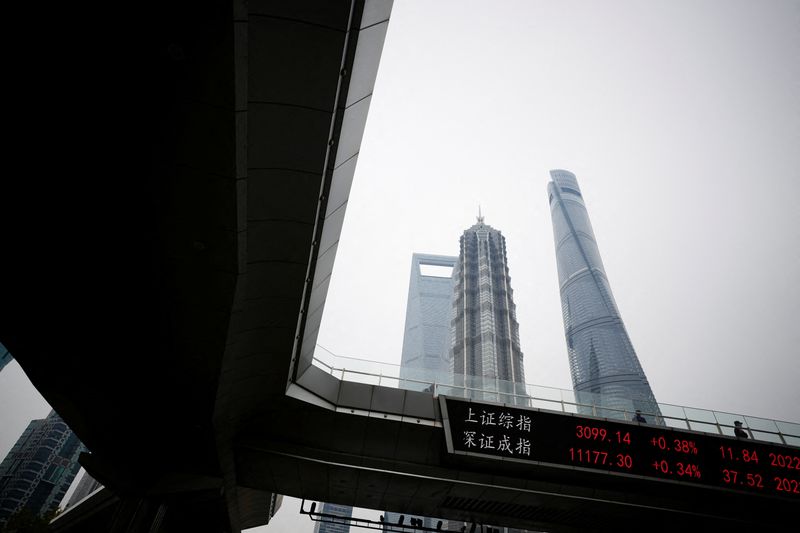By Summer Zhen and Samuel Shen
HONG KONG/SHANGHAI (Reuters) -Disillusioned with a weak stock market at home, geopolitical risks and a falling currency, Chinese investors are pouring money into investment products with exposure to overseas assets that will also help diversify their portfolios.
Retail money has gushed into exchange traded funds (ETFs) and mutual funds issued under the Qualified Domestic Institutional Investor (QDII) programme, one of the few channels for Chinese money to be invested abroad, leaving managers of these funds scrambling for more quotas under the strictly managed scheme.
Those investing in QDII products are no longer content staying close to home in Hong Kong equities but are seeking funds that give them access to U.S, Japanese and even emerging markets such as Vietnam and India as the Chinese economy stumbles, analysts said.
A record 38 QDII funds had been launched this year until August 17, outpacing the 31 funds launched in 2022, Morningstar data shows.
"Demand for U.S. stocks has emerged since late last year and has strengthened this year due to the lucrative returns. The Nasdaq ETF sold exceptionally well," said Ivan Shi, head of research at Shanghai-based fund consultancy Z-Ben Advisors.
The total QDII quota of roughly $165.5 billion is almost used up, and there is demand for more, fund managers say, as domestic investors seek alternatives to falling stock and property values at home.
Money has been leaving China's shores all year, not just through QDII funds but also its Stock Connect and Bond Connect links with Hong Kong, complicating authorities' efforts to stabilise the yuan and revive confidence.
The blue chip CSI300 index is among the world's worst-performing major indexes this year, down roughly 2%, after tumbling 22% in 2022. The yuan is down more than 5% against the U.S. dollar this year.
In contrast, the Dow Jones Industrial Average is up 4.3% and Nasdaq has jumped roughly 30%.
QUOTAS
Asset managers are finding the State Administration of Foreign Exchange (SAFE) is slow in approving further QDII quota, having already granted $5.8 billion in quotas in two rounds this year.
Tianhong Asset Management, which is backed by Ant Financial, launched three QDII products in the first half of the year, with mandates to track the Nasdaq 100 Index, overseas high-end manufacturing shares and overseas electric vehicles stocks. The size of its fund investing in Vietnam hit a record this year.
Tianhong, which is planning new QDII products, obtained a $120 million fresh QDII quota in July, less than it had hoped for.
"Many asset managers have felt they are short of their offshore investment quota recently and want more," said Liu Dong, head of Tianhong's international business.
Becky Liu, head of China macro strategy at Standard Chartered (OTC:SCBFF) Bank, reckons the QDII quota issuance has slowed and regulators may discourage overseas investments as part of efforts to stabilize the yuan.
China has already asked domestic lenders to scale back outflows via Bond Connect, sources told Reuters last week.
Liu expects capital outflows could hit historical highs and says the situation is unlike the 2015 bout of massive outflows amid yuan depreciation "which was driven by those gray area transactions."
"This round is mainly through legitimate channels. Rather than foreign capital selling China equities, this time it's Chinese investors’ outbound investment,” Liu said.
HUGE DEMAND
The QDII program, launched in 2006, remains a key outbound investment channel for mainland Chinese investors, alongside the Qualified Domestic Limited Partnership (QDLP) programme.
Hot demand has driven the combined size of QDII mutual funds to more than 400 billion yuan ($54.85 billion) by the end of July for the first time, data from the Asset Management Association of China (AMAC) shows. By July, there were a total of 255 QDII mutual funds in the market, according to AMAC.
Assets under management (AUM) at Guangfa NASDAQ-100 ETF, one of the largest QDII ETFs, jumped 48% in the first half to 17 billion yuan, while some other popular QDII funds such as E Fund’s S&P Information Technology Index Fund and S&P 500 Fund had to suspend subscription earlier this year to control their fund sizes.
JP Morgan Asset Management, which runs a sizeable cross border business in China, said it has seen rising interest in offshore funds and is launching a new Nasdaq 100 QDII fund in September, after its Japan-focused equity fund more than tripled in the first half of 2023.
"In the longer term, we believe the interest is here to stay due to onshore investors’ global diversification demands," said Desiree Wang, CEO of J.P. Morgan Asset Management China.
Tracy Liu, an individual investor working in the information technology industry, invested in an India-focused QDII fund in March.

Liu said he was betting that India would be the next China and “the country is in a better position as it has maintained good relations with both the U.S. and Russia.”
($1 = 7.2922 Chinese yuan renminbi)